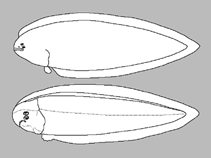http://www.fishbase.org/Summary/speciesSummary.php?genusname=Symphurus&speciesname=ommaspilus ---> http://192.134.151.83/Summary/speciesSummary.php?genusname=Symphurus&speciesname=ommaspilus
http://192.134.151.83/Summary/speciesSummary.php?genusname=Symphurus&speciesname=ommaspilus ---> https://fishbase.mnhn.fr/Summary/speciesSummary.php?genusname=Symphurus&speciesname=ommaspilus
https://fishbase.mnhn.fr/Summary/speciesSummary.php?genusname=Symphurus&speciesname=ommaspilus ---> https://fishbase.mnhn.fr/summary/Symphurus-ommaspilus.html
Symphurus ommaspilus, Ocellated tonguefish

You can
sponsor
this page
Common name (e.g. trout)
Genus + Species (e.g. Gadus morhua)
-

-
About this page
-
Languages
-
User feedbacks
-
Citation
-
Uploads
-
Related species
-


 Ocellated tonguefish
Add your observation in
Fish Watcher
Upload your
photos
and
videos
Ocellated tonguefish
Add your observation in
Fish Watcher
Upload your
photos
and
videos
Google image
 No image available for this species;
No image available for this species;
drawing shows typical species in Cynoglossidae.
Teleostei (teleosts) >
Pleuronectiformes
(Flatfishes) >
Cynoglossidae
(Tonguefishes) > Symphurinae
Etymology:
Symphurus:
Greek, syn, symphysis = grown together + Greek, oura = tail (Ref.
45335
)
.
Environment: milieu / climate zone / depth range / distribution range
Ecology
Marine; demersal; depth range 1 - 27 m (Ref.
26268
). Tropical; 27°N - 10°N, 89°W - 60°W (Ref.
26268
)
Western Central Atlantic: Widespread through insular regions of the Caribbean Sea, including Glover's Reef, St. Eustatius, St. Barthelemy, and the French West Indies. Rarely captured along the continental margins of the Caribbean.
Length at first maturity / Size / Weight / Age
Maturity: L
m
?
, range 3 - ? cm
Max length : 4.3 cm SL male/unsexed; (Ref.
53028
); 5.7 cm SL (female)
Short description
Morphology
|
Morphometrics
Dorsal
soft rays
(total): 76-77;
Anal
soft rays
: 61 - 62. Slender, small; pale with distinct, dark ocellated spots near rear of dorsal and anal fins.
Inhabits sandy substrates, also those submerged beds of aquatic vegetation, in clear shallow waters near coral reefs. Little is known of its biology since its captured infrequently and generally in small numbers; most captures were a single fish (Ref.
26268
).
Life cycle and mating behavior
Maturity
|
Reproduction
|
Spawning
|
Eggs
|
Fecundity
|
Larvae
B├Âhlke, J.E. and C.C.G. Chaplin
, 1993. Fishes of the Bahamas and adjacent tropical waters. 2nd edition. University of Texas Press, Austin. (Ref.
5521
)
IUCN Red List Status (Ref.
130435
)
Least Concern (LC)
; Date assessed:
23 August 2012
CITES
Not Evaluated
Not Evaluated
Threat to humans
Harmless
Human uses
Fisheries: of no interest
FAO - Publication:
search
|
FishSource
|
More information
Countries
FAO areas
Ecosystems
Occurrences
Introductions
Stocks
Ecology
Diet
Food items
Food consumption
Ration
Common names
Synonyms
Metabolism
Predators
Ecotoxicology
Reproduction
Maturity
Spawning
Spawning aggregation
Fecundity
Eggs
Egg development
Age/Size
Growth
Length-weight
Length-length
Length-frequencies
Morphometrics
Morphology
Larvae
Larval dynamics
Recruitment
Abundance
BRUVS
References
Aquaculture
Aquaculture profile
Strains
Genetics
Electrophoreses
Heritability
Diseases
Processing
Nutrients
Mass conversion
Collaborators
Pictures
Stamps, Coins Misc.
Sounds
Ciguatera
Speed
Swim. type
Gill area
Otoliths
Brains
Vision
Tools
E-book
|
Field guide
|
Identification keys
|
Length-frequency wizard
|
Life-history tool
|
Point map
|
Classification Tree
|
Catch-MSY
|
Special reports
Check for Aquarium maintenance
|
Check for Species Fact Sheets
|
Check for Aquaculture Fact Sheets
Download XML
Summary page
|
Point data
|
Common names
|
Photos
Internet sources
AFORO (otoliths) |
Aquatic Commons
|
BHL
|
Cloffa
|
BOLDSystems
|
Websites from users
|
Check FishWatcher
|
CISTI
|
Catalog of Fishes
:
genus
,
species
|
DiscoverLife
|
ECOTOX
| FAO - Publication:
search
|
Faunafri
| Fishipedia |
Fishtrace
| GenBank:
genome
,
nucleotide
| GloBI |
Google Books
|
Google Scholar
|
Google
| IGFA World Record |
MitoFish
|
National databases
|
Otolith Atlas of Taiwan Fishes
|
PubMed
| Reef Life Survey | Socotra Atlas |
Tree of Life
| Wikipedia:
Go
,
Search
| World Records Freshwater Fishing |
Zoobank
|
Zoological Record
Estimates based on models
Preferred temperature (Ref.
123201
): 26.6 - 28.2, mean 27.4 °C (based on 290 cells).
Phylogenetic diversity index (Ref.
82804
): PD
50
= 0.5000 [Uniqueness, from 0.5 = low to 2.0 = high].
Bayesian length-weight: a=0.01445 (0.00647 - 0.03228), b=3.05 (2.85 - 3.25), in cm total length, based on LWR estimates for this (Sub)family-body shape (Ref.
93245
).
Trophic level (Ref.
69278
): 3.2 ±0.4 se; based on size and trophs of closest relatives
Resilience (Ref.
120179
): High, minimum population doubling time less than 15 months (Preliminary K or Fecundity.).
Fishing Vulnerability (Ref.
59153
): Low vulnerability (10 of 100).
Back to Search
Random Species
Back to Top
Accessed through:
Not available
FishBase mirror site :
localhost
Page last modified by :
mrius-barile
- 20 July 2016
Fatal error
: Uncaught ArgumentCountError: Too few arguments to function checkEcotox(), 1 passed in /var/www/html/summary/speciessummary.php on line 2304 and exactly 3 expected in /var/www/html/includes/speciessummary.lib.php:2579 Stack trace: #0 /var/www/html/summary/speciessummary.php(2304): checkEcotox() #1 {main} thrown in
/var/www/html/includes/speciessummary.lib.php
on line
2579
|